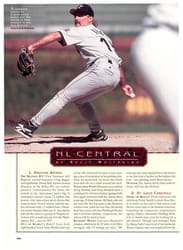
JUST AS IN 1992, DAVIES PREDICTS THAT EUROPE WILL COP THE SOLHEIM CUP MERION VS. BETHPAGE JACK'S SOUP DIET
LAURA'S THEME II
LAURA DAVIES is talking tough about the Solheim Cup. At last
week's Standard Register Ping Classic in Phoenix, Davies took a
shot at the U.S. team while predicting a European victory in
September. "We're getting stronger. They're getting older,"
Davies said.
It's a little early for bulletin-board material, but Davies does
have a point about Europe's getting stronger since being pasted
13-7 in 1994. With the development of Annika Sorenstam, the
resurgence of Liselotte Neumann and the continued excellence of
Davies's own play, the Europeans could field the top three women
players in the world at St. Pierre Golf Club in Chepstow, Wales.
As for the American team's getting older, yes, Beth Daniel (39),
Patty Sheehan (39) and Betsy King (40) are no longer kids, but
they aren't collecting Social Security either. And behind them
are Kelly Robbins and Michelle McGann, who have yet to celebrate
their 27th birthdays. Normally combative Dottie Pepper, who was
criticized for openly rooting against her opponents during the
last Solheim Cup, let Davies's comments pass with a wry smile.
"I guess Laura's right," Pepper said. "After all, I did just
turn 30."
What could, in the end, benefit Judy Rankin's U.S. team the most
was the decision to expand the competition so that 12 players
from each side will participate instead of 10. The LPGA is much
deeper than the European tour. Of course, the same thing was
said about the PGA Tour before the Ryder Cup last year.
Davies is the one person who can get away with making brash
statements because she has proved that she can back up her
words. In 1992 Europe appeared to be badly overmatched going
into the inaugural Solheim Cup, but Davies predicted a European
win, then rallied her teammates to a stunning 11 1/2-6 1/2
victory.
Clearly the most dominant player in women's golf, Davies showed
no signs of letting up last week in Phoenix, winning the
Standard Register Ping for a third consecutive year and becoming
the first LPGA player to take an event three straight times
since Sandra Haynie won Charity Golf Classics in 1973, '74 and
'75.
TWO FOR THE SHOW
Courses from opposite sides of the tracks, Merion and Bethpage
Black, have emerged as the two favorites to host the 2001 U.S.
Open. Merion, near Philadelphia, which had to surrender the 1994
U.S. Women's Open because it did not comply with the U.S. Golf
Association's membership guidelines (it didn't have any
African-American members), is one of the most exclusive clubs in
the East. Bethpage, on Long Island, is the quintessential muni
where golfers line up at 4 a.m. for starting times.
Minority membership is no longer a problem at Merion, and the
USGA scoffs at the notion that the 84-year-old course isn't long
enough (at 6,544 yards, it is the shortest to have hosted an
Open). The association's only worry is that because of limited
parking and access roads, just 18,000 tickets can be sold daily.
Trains and a bus system could solve the traffic flow problem, as
they did at Oakmont in Pittsburgh in 1994.
Merion has held four Opens, the last in 1981. It was won by
David Graham with a score of 273, seven under par. "A lot of
people had questioned whether the game had passed Merion by,"
says USGA executive director David Fay. "I don't think that's
the case. Merion has always had a number of holes that were not
driver holes. They were layup holes in 1934, and they still are
today."
Concerning Bethpage, some wonder why it should be given an Open
without first paying dues by hosting a lesser USGA championship.
Also, the condition of the public course has been questioned.
Fay says holding other events is not a criterion for being
awarded an Open. And he dismisses those who say the course is
too rough around the edges. "Using automobile terminology, some
people have said we need to put in a new engine," Fay says. "I
disagree. With that layout, it's more like a detailing job."
HONOR STUDENT
Two years ago Tim Herron postponed his pro career for a semester
to get his degree from New Mexico. To those closest to Herron,
earning the diploma--with a 3.2 grade point average--was every bit
as impressive as his recent victory in the Honda Classic. The
reason: Herron suffers from an auditory learning disability that
has always made school difficult.
"It's a retention thing," says Herron's father, Carson. "We
discovered in grade school that he was a step behind." Special
tutoring classes got Herron through Wayzata (Minn.) High with a
B-plus average, but his SATs barely met NCAA requirements.
Herron put in extra time at New Mexico's Student Service Center
and Athletic Academic Advisement department and not only
remained eligible for the Lobos' golf team but also nearly
qualified as an Academic All-America.
"People don't understand how hard it was for Tim to get it done,
and yet he got it done," says John Fields, who coached Herron at
New Mexico. "Some of his contemporaries did not get their
degrees, but he decided it was important."
Herron, who was inspired in high school by a video about
dyslexic race car driver Jackie Stewart, would like to serve as
an example to others with learning disabilities. "When you're a
kid, you tend to shy away from your problems," Herron says. "I'd
just get scatterbrained if I had more than one thing in front of
me, but I always worked hard. Now I'd like to help people like
me. I'd like to show them that they can do it too."
FAST AND EASY
A cold winter in north Florida could result in lower scores at
this week's Players Championship, which celebrates its 15th
anniversary at the Tournament Players Club at Sawgrass. Although
Fred Klauk, the superintendent, again has the greens firm and
fast for the so-called "fifth major," the rough at the Stadium
Course won't be as thick as it was in 1995, when the winning
score was five under par and only 10 players finished in the
red. "I've gone through an evolution with the players," says
Klauk, who took a lot of heat when Greg Norman finished 24 under
to win in 1994. "When the course opened [in 1982], it was too
difficult. We tried to make the players happy, but they said it
was too easy. I think we've finally got it where they want it."
THE SHORT GAME
Victories by Paul Goydos (Bay Hill), Scott McCarron (New
Orleans) and Herron have increased the Masters field to 93, the
largest since 103 competed in 1966.... Danny Yates, the 1992
Mid-Amateur champion, has once more been put on call to serve as
a marker at the Masters. Yates was the marker when Jeff Maggert
had his double eagle on 13 in 1994 and again when Jack Nicklaus
eagled the 5th hole for the second time in the tournament last
year.... New from Karsten Manufacturing: an old-fashioned
wooden-headed mallet putter, the Danser ($175). Laura Davies
used it in the opening round of the Standard Register Ping and
took just 26 putts.
COLOR PHOTO: JIM GUND Europe's leader, Davies made a statement by winning again in Phoenix. [Laura Davies]
COLOR PHOTO: JOHN BURGESS [Jack Nicklaus]
JACK'S SOUP DIET
Earlier this year, when Jack Nicklaus noticed that he weighed
more than 200 pounds--"I hadn't been that heavy since I was a
kid," Jack says--he decided to do something about it. Several
weeks later, thanks to a diet that features cabbage soup (all
you can slurp), Nicklaus has dropped 17 pounds and now weighs in
at 185 (left), one pound less than when he won the Masters in
1986. Nicklaus received so many requests from other players at
last week's Legends (even from his partner, longtime health nut
Gary Player) that Barbara Nicklaus had copies of the diet, and
her recipe for cabbage soup, passed around the locker room. "I'm
thinking of charging a dollar," she says.
Fat-Burning Cabbage Soup
1 or 2 cans crushed tomatoes
6 large green onions
1 large can beef broth
1 package Lipton onion soup mix
1 head cabbage, chopped
2 cans green beans
2 green peppers
2 lbs. carrots
1 bunch celery
Season with salt, pepper, curry or parsley if desired, or hot
sauce. Cut vegetables into medium pieces, boil fast for 10
minutes, reduce to simmer, cook until tender.
THE DAILY MEAL PLAN
Day One: Eat only soup and fruit. (Any fruit except bananas.
Cantaloupe and melon are the lowest in calories.)
Day Two: All the fresh, canned or raw vegetables and soup you
want. No fruit. At dinner, reward yourself with a buttered baked
potato.
Day Three: Eat all the soup, vegetables and fruit you want. Do
not have a baked potato or bananas. If you have eaten as
directed, you should have lost three to seven pounds.
Day Four: Eat at least three bananas and drink as much skim milk
as you can, along with the soup. Your body will need the
potassium, carbs, protein and calcium to lessen a craving for
sweets.
Day Five: You may have 10 to 20 ounces of beef and as many as
six tomatoes. Eat the soup at least once.
Day Six: You can have as many as two or three steaks if you
like, with green leafy vegetables. No potato. Be sure to eat the
soup at least once.
Day Seven: Brown rice, vegetables and unsweetened fruit juices.
Again, be sure to eat the soup. You should have lost 7-14 pounds
by now.

